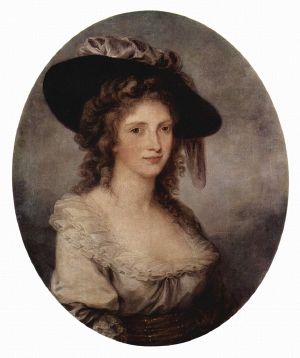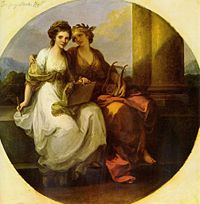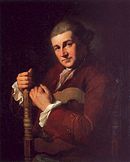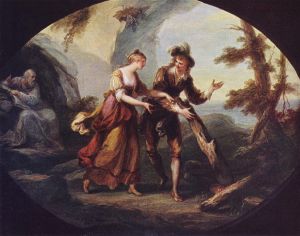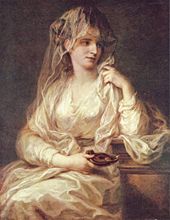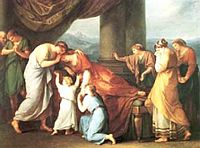Angelica Kauffmann
Maria Anna Angelika/Angelica Katharina Kauffmann (October 30, 1741 – November 5, 1807) was a gifted Swiss painter (trained by her father), portraitist, etcher, designer, miniaturist, and printmaker. She was a child prodigy who produced commissioned portraits in her early teens. She was especially fond of historic painting.
She also lived in England and Italy, spoke French, German and English fluently. She was very popular during her own lifetime and friends with notables such as Goethe and Sir Joshua Reynolds, whose influence added her name to the signatories of the famous petition to the king of England, for the establishment of the Royal Academy of Painting and Sculpture of which she was a founding member, and she was one of London's most sought-after portraitists, and by 1787, probably one of the most famous and successful living painters in Rome.
Early Life
She was born at Chur in Graubünden, Switzerland, but grew up in Schwarzenberg in Vorarlberg/Austria. She was trained by her father, the Swiss muralist Johann Joseph Kauffmann, a poor man and mediocre painter, but apparently very successful in teaching his precocious daughter. During the early 1760s Angelica Kauffmann traveled through Switzerland, Austria, and Italy, working as her father's assistant. From which she had the rare opportunity for a woman to see and copy the works of ancient and Renaissance masters and to meet leaders of the popular new movement known as neoclassicism.
She rapidly acquired several languages, read incessantly, and showed marked talents as a musician. Her greatest progress, however, was in painting; and in her twelfth year she had become a notability, with bishops and nobles for her sitters. In 1754 her father took her to Milan. Later visits to Italy of long duration followed: in 1763 she visited Rome, returning again in 1764. From Rome she passed to Bologna and Venice, being everywhere feted and caressed, as much for her talents as for her personal charms.
Fame as a painter
Writing from Rome in August 1764 to his friend Franke, Johann Winckelmann, (German art historian and archaeologist) refers to her exceptional popularity. She was then painting his picture, a half-length, of which she also made an etching. She spoke Italian as well as German, he says; and she also expressed herself with facility in French and English, one result of the accomplishment of English, was that she became a popular portraitist for English visitors to Rome. "She may be styled beautiful," he adds, "and in singing may vie with our best virtuosi." While at Venice, she was induced by Lady Wentworth, the wife of the English ambassador, to accompany her to London. One of her first works was a portrait of David Garrick, exhibited in the year of her arrival at "Mr Moreing's great room in Maiden Lane." The rank of Lady Wentworth opened society to her, and she was well received everywhere she went, the royal family especially showing her great favor.
Her firmest friend, however, was Sir Joshua Reynolds. In his pocket-book, her name as Miss Angelica or Miss Angel appears frequently, and in 1766 he painted her, a compliment which she returned by her Portrait of Sir Joshua Reynolds. Another instance of her intimacy with Reynolds is to be found in her variation of Guercino's Et in Arcadia ego, a subject which Reynolds repeated a few years later in his portrait of Mrs. Bouverie and Mrs. Crewe.
When, in about November 1767, she was entrapped into a clandestine marriage with an adventurer who passed for a Swedish count (the Count de Horn), Reynolds helped extract her. It was doubtless owing to his good offices that she was among the signatories to the famous petition to the king for the establishment of the Royal Academy of Painting and Sculpture of which she became a member. In its first catalog of 1769 she appears with "R.A." after her name (an honor she shared with one other lady, Mary Moser); and she contributed the Interview of Hector and Andromache, and three other classical compositions.
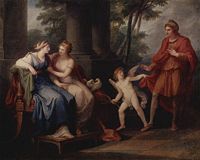
Her friendship with Reynolds was criticized in 1775 by fellow Academician Nathaniel Hone in his satirical picture "The Conjurer." This attacked the fashion for Italianate Renaissance art, ridiculed Reynolds, and included a nude caricature of Kauffmann, later painted out by Hone. The work was rejected by the Royal Academy.
From 1769 until 1782, she was an annual exhibitor, sending sometimes as many as seven pictures, generally classic or allegorical subjects. One of the most notable was Leonardo expiring in the Arms of Francis the First 1778. In 1773 she was appointed by the Academy with others to decorate St Paul's Cathedral, and it was she who, with Biagio Rebecca, painted the Academy's old lecture room at Somerset House.
Unique talent
Kauffmann's strength was her work in history painting, the most elite and lucrative category in academic painting during the 18th century. Under the direction of Sir Joshua Reynolds, the Academy made a strong effort to promote history painting to a native audience who were more interested in commissioning and buying portraits and landscapes. Despite the popularity that Kauffmann enjoyed in English society and her success as an artist, she was disappointed by the relative apathy that the English had for history painting. Ultimately, she left England for the continent where history painting was better established, esteemed, and patronized.
It is probable that her popularity declined a little in consequence of her unfortunate marriage; but in 1781, after her first husband's death (she had been long separated from him), she married Antonio Zucchi (1728–1795), a Venetian artist then resident in England. Shortly afterward they returned to Rome where her studio became a focal point for that city’s cultural life. In Rome, she befriended, among others, Johann Wolfgang von Goethe, who said she worked harder and accomplished more than any artist he knew, yet always restive she wanted to do more [1] and lived for 25 years with much of her old prestige. In 1782 she lost her father; and in 1795, her husband. She continued at intervals to contribute to the Academy, her last exhibit being in 1797.
After this she produced little, and in 1807 she died in Rome. By the time of her death she had achieved such renown that her funeral was directed by the prominent Neoclassical sculptor Antonia Canova, who based it on the funeral of the Renaissance master Raphael. The entire Academy of St. Luke, with numerous ecclesiastics and virtuosi, followed her to her tomb in San Andrea delle Fratte, and, as at the burial of Raphael, two of her best pictures were carried in procession.
Legacy
The works of Angelica Kauffmann have not retained their reputation. She had a certain gift of grace, and considerable skill in composition. But her figures lack variety and expression; and her men are masculine women. Her coloring, as described by Gustav Friedrich Waagen, is "cheerful." As of 1911, rooms decorated by her brush were still to be seen in various quarters. At Hampton Court was a portrait of the duchess of Brunswick; in the National Portrait Gallery, was a self-portrait. [2] There were other pictures by her at Paris, at Dresden, in the Hermitage at St. Petersburg, and in the Alte Pinakothek at Munich. The Munich example was another portrait of herself done in 1767, [3] and there was a third in the Uffizi at Florence. A few of her works in private collections were exhibited among the Old Masters at Burlington House. But she is perhaps best known by the numerous engravings from her designs by Schiavonetti, Bartolozzi and others. Those by Bartolozzi especially still found considerable favor with collectors.
A Scene from Troilus and Cressida is one of two paintings Kauffmann contributed to Boydell's Shakespeare Gallery. [4] Kauffmann kept good records of her works and the amounts paid for them, she was a good accountant as well as a competent painter.
A warm-hearted woman and friend, she was a colleague of Mary Moser, a teacher of Robert Home, a mentor of Maria Cosway, Georgiana Keate, and a mentor and cousin of Rosa Florini. She shared her talents and encouraged other women to paint as well.
Charles Willson Peale (1741-1827), artist, patriot, and founder of a major American art dynasty, named several of his children after great European artists, including a daughter, Angelica Kauffman Peale. Her life was written in 1810 by Giovanni de Rossi. It has also been used as the basis of a romance by Leon de Wailly (1838) and it prompted the charming novel contributed by Mrs. Richmond Ritchie to the Cornhill Magazine in 1875 entitled Miss Angel.
She should not be confused with Austrian painter Angelika Kaufmann who was born in 1935 in Carinthia, Austria.
Notes
- ↑ Goethe's 'Italian Journey' 1786-1788.
- ↑ Self Portrait "In this self portrait, Kauffmann holds a portfolio and 'porte-crayon', containing her charcoal. She wears an imaginary 'classical' garment which refers to her place in a lineage of artists. By distancing herself from society and fashion, and depicting herself with the tools of her trade, she makes claims for her principle identity as artist rather than as a woman." www.npg.org.uk Retrieved September 13, 2008.
- ↑ Self-portrait In German. www.pinakothek.de Retrieved September 13, 2008.
- ↑ "It is Plate XXXV, Volume II of The Boydell Shakespeare Prints. The painting was begun in 1788 and displayed at the Shakespeare Gallery when it first opened in 1789. Kauffmann kept records of her work and she has this entry with the heading "Rome, February 1789": she says the painting represents a scene where Cressida, wife of Troilus. being a prisoner in the camp of the Greeks, is in the tent of Calchas, the great priest and her father, she is in amorous conversation with Diomedes. Troilus comes during the period of Armistice to visit the camp, accompanied by Ulysses and another warrior. He sees his wife in loving discourse with Diomedes and he wants to rush into the tent to catch them by surprise, but Ulysses and the others keep him back by force. The scene is rose-tinted by torchlight, settled for 200 guineas..." Shakespeare Illustrated shakespeare.emory.edu Retrieved September 13, 2008.
ReferencesISBN links support NWE through referral fees
- de Wailly, Leon. Angelica Kauffmann: Volume 2, Adamant Media Corporation, 2001. ISBN 978-1421241449
- Fine, Elsa Honig. Women & art : a history of women painters and sculptors from the renaissance to the 20th century, Montclair, N.J.: Allanheld & Schram/Prior, 1978. ISBN 9780839002123 OCLC 3415319
- Kaufmann, Angelica, and Tobias G Natter. Angelica Kauffman : a woman of immense talent, Ostfildern : Hatje Cantz ; Maidstone : Amalgamated Book Services [distributor], 2007. ISBN 9783775719841 OCLC 154788084
- Mayer, Dorothy Moulton Piper. Angelica Kauffmann, R.A., 1741-1807, Gerrards Cross, Smythe, 1972. ISBN 9780900675683 OCLC 624436
- Rideal, Liz, Whitney Chadwick and Frances Borzello. Mirror Mirror: Self-portraits by women artists, 2001. Watson-Guptill, 2002. ISBN 978-0823030712
- Rideal, Liz. Insights: Self Portrait, National Portrait Gallery Publications, 2006. ISBN 978-1855143630
- Rogers, Malcolm. Master Drawings from the National Portrait Gallery, National Portrait Gallery, 1993. ISBN 978-1855141346
- Rosenthal, Angela. Angelica Kauffman: Art and Sensibility. New Haven, Connecticut: Yale University Press, 2006. ISBN 0300103336
- This article incorporates text from the Encyclopædia Britannica Eleventh Edition, a publication now in the public domain.
External links
All Links Retrieved May 28, 2008.
- Angelika Kauffmann website in English, Italian and German www.angelika-kauffmann.com
Credits
New World Encyclopedia writers and editors rewrote and completed the Wikipedia article in accordance with New World Encyclopedia standards. This article abides by terms of the Creative Commons CC-by-sa 3.0 License (CC-by-sa), which may be used and disseminated with proper attribution. Credit is due under the terms of this license that can reference both the New World Encyclopedia contributors and the selfless volunteer contributors of the Wikimedia Foundation. To cite this article click here for a list of acceptable citing formats.The history of earlier contributions by wikipedians is accessible to researchers here:
The history of this article since it was imported to New World Encyclopedia:
Note: Some restrictions may apply to use of individual images which are separately licensed.
Category:art, music, literature, sports and leisure]]
